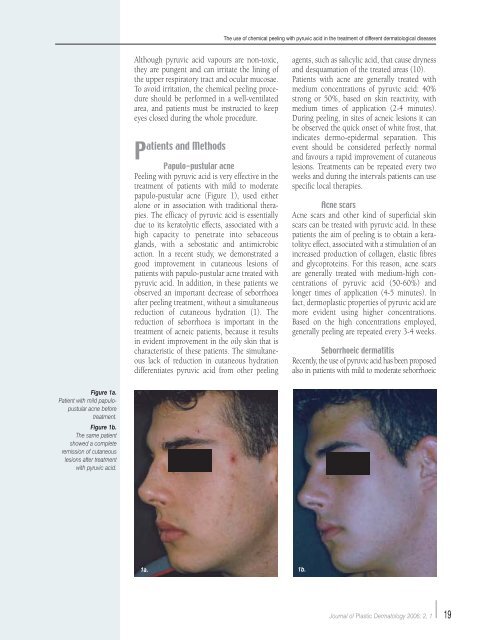Aprile Vol.2 N° 1 - 2006 - Salute per tutti
Aprile Vol.2 N° 1 - 2006 - Salute per tutti
Aprile Vol.2 N° 1 - 2006 - Salute per tutti
You also want an ePaper? Increase the reach of your titles
YUMPU automatically turns print PDFs into web optimized ePapers that Google loves.
Figure 1a.<br />
Patient with mild papulopustular<br />
acne before<br />
treatment.<br />
Figure 1b.<br />
The same patient<br />
showed a complete<br />
remission of cutaneous<br />
lesions after treatment<br />
with pyruvic acid.<br />
Although pyruvic acid vapours are non-toxic,<br />
they are pungent and can irritate the lining of<br />
the up<strong>per</strong> respiratory tract and ocular mucosae.<br />
To avoid irritation, the chemical peeling procedure<br />
should be <strong>per</strong>formed in a well-ventilated<br />
area, and patients must be instructed to keep<br />
eyes closed during the whole procedure.<br />
atients and Methods<br />
P<br />
Papulo-pustular acne<br />
Peeling with pyruvic acid is very effective in the<br />
treatment of patients with mild to moderate<br />
papulo-pustular acne (Figure 1), used either<br />
alone or in association with traditional therapies.<br />
The efficacy of pyruvic acid is essentially<br />
due to its keratolytic effects, associated with a<br />
high capacity to penetrate into sebaceous<br />
glands, with a sebostatic and antimicrobic<br />
action. In a recent study, we demonstrated a<br />
good improvement in cutaneous lesions of<br />
patients with papulo-pustular acne treated with<br />
pyruvic acid. In addition, in these patients we<br />
observed an important decrease of seborrhoea<br />
after peeling treatment, without a simultaneous<br />
reduction of cutaneous hydration (1). The<br />
reduction of seborrhoea is important in the<br />
treatment of acneic patients, because it results<br />
in evident improvement in the oily skin that is<br />
characteristic of these patients. The simultaneous<br />
lack of reduction in cutaneous hydration<br />
differentiates pyruvic acid from other peeling<br />
1a. 1b.<br />
The use of chemical peeling with pyruvic acid in the treatment of different dermatological diseases<br />
agents, such as salicylic acid, that cause dryness<br />
and desquamation of the treated areas (10).<br />
Patients with acne are generally treated with<br />
medium concentrations of pyruvic acid: 40%<br />
strong or 50%, based on skin reactivity, with<br />
medium times of application (2-4 minutes).<br />
During peeling, in sites of acneic lesions it can<br />
be observed the quick onset of white frost, that<br />
indicates dermo-epidermal separation. This<br />
event should be considered <strong>per</strong>fectly normal<br />
and favours a rapid improvement of cutaneous<br />
lesions. Treatments can be repeated every two<br />
weeks and during the intervals patients can use<br />
specific local therapies.<br />
Acne scars<br />
Acne scars and other kind of su<strong>per</strong>ficial skin<br />
scars can be treated with pyruvic acid. In these<br />
patients the aim of peeling is to obtain a keratolityc<br />
effect, associated with a stimulation of an<br />
increased production of collagen, elastic fibres<br />
and glycoproteins. For this reason, acne scars<br />
are generally treated with medium-high concentrations<br />
of pyruvic acid (50-60%) and<br />
longer times of application (4-5 minutes). In<br />
fact, dermoplastic pro<strong>per</strong>ties of pyruvic acid are<br />
more evident using higher concentrations.<br />
Based on the high concentrations employed,<br />
generally peeling are repeated every 3-4 weeks.<br />
Seborrhoeic dermatitis<br />
Recently, the use of pyruvic acid has been proposed<br />
also in patients with mild to moderate seborrhoeic<br />
Journal of Plastic Dermatology <strong>2006</strong>; 2, 1<br />
19

















